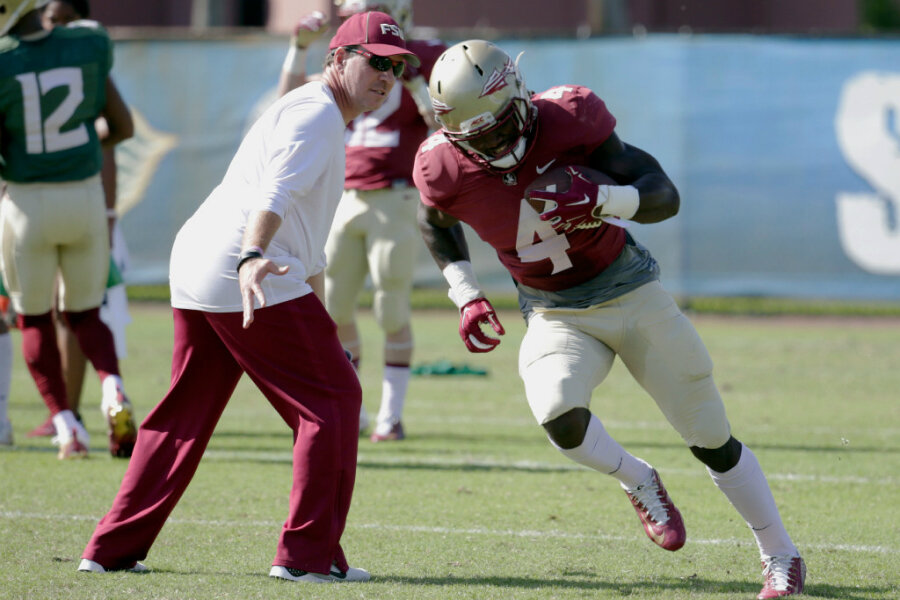NCAA prohibits collision-heavy, two-a-day football practices, impelling coaches to adapt
The two-a-day football practices that coaches once used to toughen up their teams and cram for the start of the season are going the way of tear-away jerseys and the wishbone formation.
As part of its efforts to increase safety, the NCAA approved a plan this year that prevents teams from holding multiple practices with contact in a single day.
The move has forced plenty of schools to alter their practice calendar, with many teams opening their preseason as early as this week. Officials don't mind if it causes a few logistical headaches as long as it reduces the head injuries that had become all too common this time of year.
According to the NCAA's Sport Science Institute, 58 percent of the football practice concussions that occur over the course of a year happen during the preseason. Brian Hainline, the NCAA's chief medical officer, says August also is a peak month for catastrophic injuries resulting from conditioning rather than contact, such as heatstroke and cardiac arrest.
"There was just something about that month really stood out," Mr. Hainline said. "We couldn't say with statistical certainty if this was because of the two-a-days, but there was enough consensus in the room and enough preliminary data that it looked like it was because of the two-a-days."
Some coaches believe the benefits could go beyond reducing concussions.
"I don't think you're going to have the number of injuries that you had, especially the soft tissue injuries – hamstring pulls, quad pulls, groin pulls," Louisiana Tech coach Skip Holtz said.
Teams still can hold two practices on a given day, but one of those practices can only be a "walkthrough" that includes no contact, helmets, pads or conditioning activities. Three hours of recovery are required between a practice and a walkthrough, though meetings can be held during that period.
"It just makes all the sense in the world," Michigan coach Jim Harbaugh said.
Most programs were trending away from two-a-day practices long before this decision.
More than three-quarters of the 89 Football Bowl Subdivision teams that responded to an Associated Press survey on the subject said they conducted multiple practices on certain days last year. But in the overwhelming majority of cases, teams made sure one of those workouts had limited or no contact.
Those teams won't have to change their approach too much.
Hainline said he didn't know exactly how many programs were still holding multiple contact workouts on certain days before the NCAA ruling, but he said it was more common in the Division II ranks than among FBS schools.
Coaches say that because players are on campus working out all year, there's no need to work them quite as hard once preseason practices begin.
"Back in the day, we used two-a-days to get in shape," Florida State coach Jimbo Fisher said. "You weren't there all summer. You didn't come until the second half. They didn't train from January until June like they do now."
Marshall athletic director Mike Hamrick, a member of the Division I football oversight committee, agrees that times have changed. As an example, he cites the grueling workouts Paul "Bear" Bryant held at Texas A&M during the 1950s, which were chronicled in the book and ESPN movie "Junction Boys."
"There ain't no 'Junction Boys' anymore because the players are in tip-top shape when we start football practice," Mr. Hamrick said.
Even so, some players say they'll miss the grind.
"Going through a two-a-day is tough, and that's a big part of football," Kansas State offensive lineman Dalton Risner said. "That builds you for the season. I wish that could go back to what we used to do."
While two-a-days already were going out of fashion, this new rule is still forcing teams to adapt in other respects.
Although the NCAA is preventing multiple full-scale workouts on the same day, teams are still permitted to hold 29 total preseason practice sessions, the same as before. That creates a dilemma for coaches trying to hold that many practices without the benefit of two-a-days. Chris Ash of Rutgers is concerned increasing the length of training camp conflicts with new NCAA rules about time demands placed on athletes and could end up increasing the overall amount of contact practices.
"We've got to manage five weeks of training camp very carefully," Mr. Ash said.
Division I schools received a blanket waiver for this season allowing them to start practice one week earlier than usual. Nearly two-thirds of the FBS programs that responded to the AP survey are starting practice in July rather than in August, as is customary.
Those early starting dates led to scheduling complications for some programs. Hamrick said Marshall will still have nearly two weeks remaining in its current summer school session when it starts practice Friday.
"If I were to take the full 29 days of practice, we would have to go back into summer school, and our players would not have a chance ever to get home after summer school and summer program," Kansas State coach Bill Snyder said.
That raises the question of whether the NCAA should continue allowing 29 practice sessions. Further complicating the matter, the oversight committee would like to find a way to have every FBS team have 14 weeks to play 12 regular-season games.
"Do we need 29 practices? Probably not," North Carolina coach Larry Fedora asked. "We can get away with less than that."






